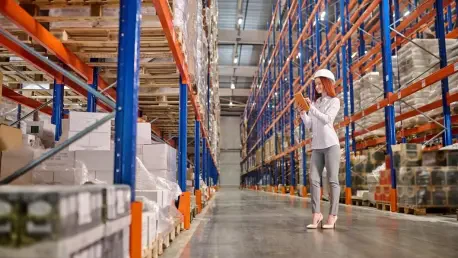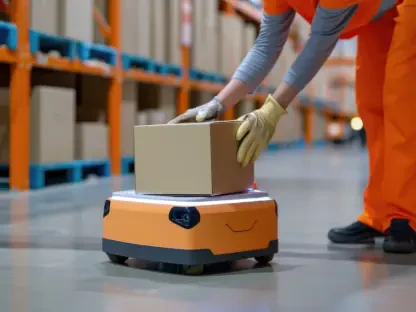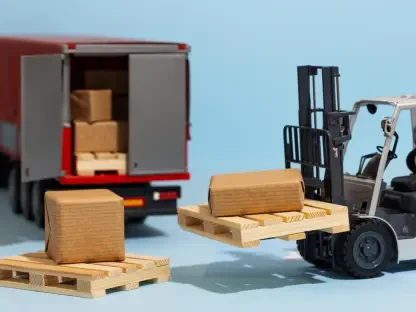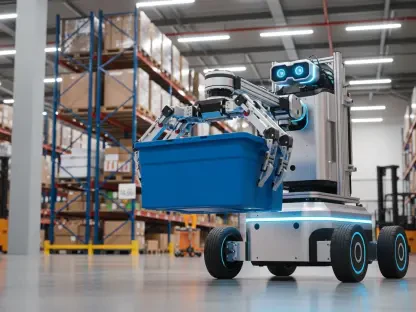What happens when a warehouse rack, loaded with thousands of pounds of inventory, comes crashing down? The consequences can be catastrophic—crushed equipment, injured workers, and losses piling up into millions. In the UK alone, rack collapses contribute to a staggering economic burden of £1.5 billion annually due to forklift impacts, overloading, and neglected maintenance. This silent threat looms over countless warehouses, yet innovative solutions are emerging to tackle the danger head-on. Enter Rack Collapse Prevention (RCP), a trailblazer in warehouse safety, offering technology that promises to stop disasters before they strike.
The importance of this story lies in the urgent need to protect workers and stabilize operations in an industry where preventable accidents still claim lives and disrupt livelihoods. RCP stands at the forefront of a national push for proactive safety measures, aligning with stringent UK policies and guidelines. This narrative unfolds the hidden risks of rack collapses, explores how cutting-edge technology can avert tragedy, and reveals why businesses can no longer afford to ignore the call for prevention over reaction.
Why Warehouse Rack Collapses Remain a Hidden Danger
Beneath the orderly shelves of bustling warehouses lies a peril often overlooked until it’s too late. Rack collapses don’t just damage goods; they endanger lives, with a single incident capable of causing severe injuries or even fatalities. Statistics paint a grim picture: the financial toll of these accidents drains the UK economy by billions each year, driven by preventable causes like improper loading and inadequate upkeep. Despite advancements in safety protocols, the persistence of such incidents raises critical questions about current practices.
Many warehouse operators underestimate the cumulative impact of small oversights, such as ignoring minor dents from forklift collisions. These seemingly trivial damages can weaken structures over time, setting the stage for catastrophic failure. The reality is that without innovative intervention, the cycle of risk continues unchecked, threatening not just employees but also the bottom line of businesses across the nation.
The Rising Tide of Prevention in Workplace Safety
Safety in warehouses has evolved from a mere compliance checkbox to a national imperative. Discussions at the Lords Grand Committee have underscored prevention as the cornerstone of reducing workplace hazards, reflecting a broader shift in mindset. While workplace fatalities in the UK have dropped significantly over recent decades, the remaining challenges—particularly rack collapses—demand urgent, forward-thinking strategies to safeguard workers.
This momentum aligns with standards set by the Health and Safety Executive (HSE) and the Royal Society for the Prevention of Accidents (RoSPA), which advocate for proactive measures. Rack collapses not only disrupt operations but also ripple through the economy, affecting families and communities. The push for prevention isn’t just about avoiding fines; it’s about preserving human lives and fostering sustainable business environments through smarter safety solutions.
RCP’s Breakthrough Rack Systems: Safety Redefined
At the heart of this safety revolution is RCP, a company engineering systems that prevent rack collapses before they occur. Their technology targets the root causes—impacts and overloading—with robust designs that withstand even the harshest conditions. Whether integrated into new warehouse constructions for long-term reliability or retrofitted into existing setups with minimal downtime, RCP’s solutions cater to diverse operational needs.
Case studies highlight the effectiveness of these systems, with businesses reporting racking stability even after significant impacts. For instance, a major logistics firm noted that after installing RCP’s protective barriers, their racks endured a severe forklift collision without buckling—a feat that saved both inventory and worker safety. This adaptability ensures that companies can prioritize safety without sacrificing efficiency or facing exorbitant costs.
Expert Perspectives: RCP and Industry Leaders Speak Out
Credibility in safety innovation comes from those who live it daily, and RCP’s Managing Director, Lee Whiting, offers a compelling viewpoint: “Prevention isn’t just about saving lives; it’s about bolstering the economy by slashing losses tied to accidents.” This sentiment echoes across the industry, where experts agree that proactive measures yield far greater benefits than reactive fixes. The consensus is clear—waiting for disaster is no longer an option.
Businesses that have adopted RCP’s technology share transformative experiences, describing smoother workflows and a newfound sense of security. A warehouse manager from a retail distribution center recounted how, post-installation, staff no longer hesitated to work near high-stacked racks, knowing the reinforced systems provided unmatched protection. Such testimonials reinforce how RCP’s mission dovetails with national objectives for safer, more resilient workplaces.
Practical Safety Steps: How RCP Makes Protection Attainable
Enhancing warehouse safety shouldn’t break the bank, and RCP ensures it doesn’t by offering tailored finance options that ease the burden of initial investments. In an era of economic uncertainty, this approach allows businesses to prioritize worker protection without compromising financial stability. Operators, whether managing new facilities or upgrading older ones, can access RCP’s expertise to implement solutions seamlessly.
For those ready to take action, the process is straightforward: assess current racking vulnerabilities, consult with RCP for customized recommendations, and integrate systems with minimal operational disruption. A practical tip includes scheduling installations during off-peak hours to avoid workflow interruptions. This framework empowers companies to fortify their environments, ensuring that safety becomes a sustainable, achievable goal for all.
Reflecting on a Safer Path Forward
Looking back, the journey to address warehouse rack collapses revealed a landscape marked by both tragedy and triumph. RCP’s innovative systems stood out as a beacon of hope, proving that technology could transform a persistent hazard into a preventable issue. The stories of businesses regaining confidence and workers operating without fear painted a vivid picture of what was possible when prevention took precedence.
The next steps were clear for warehouse operators who sought to build on this progress. Exploring RCP’s adaptable solutions offered a tangible way to protect both people and profits while aligning with national safety goals. Beyond individual action, fostering industry-wide collaboration to share best practices promised to elevate standards further, ensuring that the lessons learned paved the way for a more secure tomorrow.









